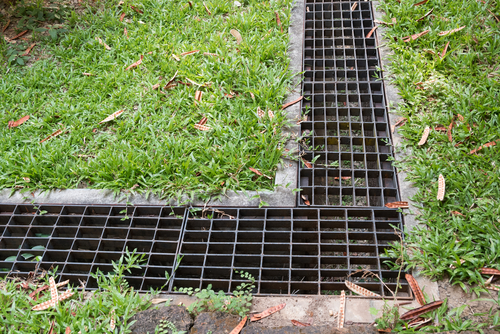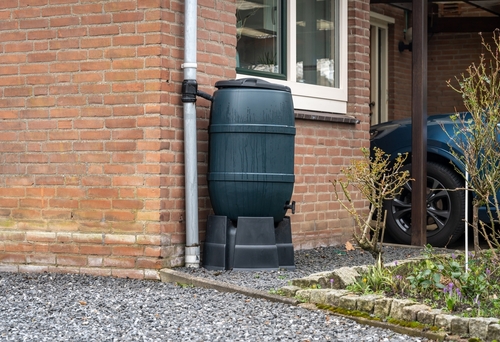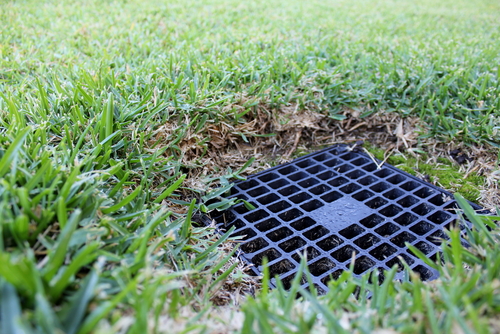March 8, 2024 - Benjamin Ehinger
Yard Drainage Solutions: Effective Ways to Solve Water Runoff Issues
CALL NOW 844-762-8449
Well-designed yard drainage is essential for maintaining a healthy landscape and protecting your home’s foundation from water damage. When your yard isn’t properly draining, it can lead to standing water, a breeding ground for mosquitoes, damage to grass and plants, and even basement leaks. If you’re noticing water pooling on your property after a rainstorm, it’s time to consider implementing effective drainage solutions. Addressing the issue promptly can save you from costly home repairs and preserve the integrity of your landscaping efforts.
Sometimes, these solutions may require significant landscape changes or the installation of new systems, which could create the need for disposing of excess soil, old pipes, and other debris. In such cases, a local dumpster rental could be a valuable resource to ensure a hassle-free cleanup process. By choosing a suitable drainage solution and planning for waste removal, you start the journey to a drier, more functional yard.
 To address yard drainage effectively, it is essential to consider solutions that improve the ground’s ability to absorb water, strategically divert water using landscaping, and capture excess water during heavy rainfall.
To address yard drainage effectively, it is essential to consider solutions that improve the ground’s ability to absorb water, strategically divert water using landscaping, and capture excess water during heavy rainfall.
 Rainwater harvesting not only aids in managing yard drainage but also in conserving water for various uses. By implementing this technique, you can mitigate flooding and contribute to a sustainable water management system.
Rainwater harvesting not only aids in managing yard drainage but also in conserving water for various uses. By implementing this technique, you can mitigate flooding and contribute to a sustainable water management system.
Key Takeaways
- Yard drainage protects landscapes and home foundations.
- Drainage solutions might involve disposing of waste with a dumpster rental.
- Addressing drainage issues promptly can prevent expensive repairs.
Understanding Yard Drainage Issues
Proper yard drainage is crucial to maintaining the health and aesthetics of your landscape. If overlooked, it can lead to extensive and costly repercussions.Common Causes of Poor Drainage
Poor yard drainage can stem from a variety of issues. Some of the most common causes include:- Compact Soil: Densely packed soil, such as clay, can greatly diminish water absorption rates.
- Uneven Terrain: Slopes and dips in your yard can direct water towards your home rather than away from it.
- Improper Landscaping: Sometimes landscaping choices can inadvertently create barriers that prevent proper drainage.
- Construction Damage: Construction projects can compact soil or alter the natural flow of water through the landscape.
Effects of Inadequate Drainage
The repercussions of inadequate drainage can vary, but typically they result in:- Water Damage: Excess water can infiltrate your home’s foundation, potentially causing structural damage.
- Landscape Erosion: Water runoff can carry away valuable topsoil, negatively affecting plant life and altering the aesthetics of your yard.
- Pest Issues: Standing water can become a breeding ground for pests like mosquitoes, which can pose health risks.
Assessing Your Yard’s Drainage Needs
Before making any changes to your yard’s drainage system, it’s critical to conduct a thorough assessment. Understanding soil composition, the layout of your landscape, and how water behaves on your property will guide you towards the most effective drainage solutions.Soil Type Analysis
Different soil types have varying capacities for water absorption and retention. Conduct a simple percolation test by digging a small hole, filling it with water, and observing how quickly it drains. This will give you insight into whether your soil is predominantly clay, sand, or loam. Clay soils tend to drain slowly and may need amending or special drainage solutions.Topography and Landscape Evaluation
Take note of your yard’s elevation changes and natural inclines. Identify any areas that are particularly prone to pooling water or erosion. Mapping out these features will help you determine where to implement solutions like a dry creek bed, as suggested by Family Handyman.Water Flow Patterns
Lastly, observe the typical water flow patterns during rainstorms. Look for places where water converges or diverges and the direction it travels. Marking these paths with brightly colored flags or stakes while it’s raining will provide a visual guide to effectively channel water away from the foundation of your home. The goal is to redirect the water flow to suitable drainage areas or solutions like French drains or trench drains.Basic Drainage Solutions
 To address yard drainage effectively, it is essential to consider solutions that improve the ground’s ability to absorb water, strategically divert water using landscaping, and capture excess water during heavy rainfall.
To address yard drainage effectively, it is essential to consider solutions that improve the ground’s ability to absorb water, strategically divert water using landscaping, and capture excess water during heavy rainfall.
Improving Soil Permeability
If your yard suffers from compacted soil or heavy clay, enhancing soil permeability is a significant first step. You can improve your soil’s drainage capabilities by mixing organic matter like compost or peat moss into the soil. This increases the soil’s structure, allowing water to filter through more efficiently, preventing waterlog and promoting healthier plant growth.Creating Swales and Berms
Swales and berms function as natural conduits and barriers in your landscape. A swale is a shallow ditch that collects and directs water flow; it’s often designed with a gentle slope to lead water away from your home. On the other hand, berms are raised areas that help divert water around important landscape features. Both can be created using soil, and incorporating plants into them can enhance their effectiveness and visual appeal.Installing Catch Basins
For more severe drainage issues, catch basins may be installed as part of an in-ground drainage system. A catch basin is a box placed in the ground at low points to collect and redirect water through a system of underground pipes. These structures are reliable solutions to prevent water accumulation in critical areas, such as your yard’s lowest points or near your home’s foundation.Advanced Drainage Systems
When designing a landscape or addressing water management issues, incorporating advanced drainage systems is crucial. These installations effectively manage excess water, reducing erosion and preventing water damage to your property.French Drains
A French drain is a gravel-filled trench that includes a perforated pipe. It is designed for water collection and redirection, pulling water away from soggy areas and dispersing it safely into the ground. Whether you have a garden that needs protection from standing water or a basement susceptible to flooding, a French drain could be an optimal solution.Dry Wells
A dry well system is an underground structure that collects and disperses stormwater. It’s essentially a holding tank for excess water, which slowly percolates back into the soil. It’s perfect for properties that experience large volumes of runoff or have non-porous soil. Using a dry well can help mitigate issues like water pooling and soil saturation.Channel Drains
Channel drains are particularly useful for removing surface water over a flat area like driveways or patios. They consist of a trench covered by a grate, which is connected to a drain pipe. As water flows into the channel, it’s directed away from your property, thus preventing water accumulation and potential damage to the pavement or foundation.Surface Solutions
Proper surface management plays a critical role in preventing water accumulation in your yard. These targeted strategies can directly improve your property’s drainage capability.Grading and Sloping
Grading your yard is foundational to ensuring effective drainage. The goal is to create a slight slope away from your home’s foundation, typically at a minimum gradient of 2%. This prevents water from pooling near your house and directs it towards designated drainage areas.Pervious Paving Options
Replace impermeable surfaces with pervious paving materials to enhance infiltration. Choices like porous asphalt, concrete, and certain types of pavers allow water to pass through the surface and naturally percolate into the soil beneath. This can drastically reduce runoff while still providing a durable surface for driveways and walkways.Rain Gardens
Create a rain garden as a dual-purpose solution: it’s a visually appealing landscape feature that also acts as a natural basin for rainwater. By planting water-tolerant plants, the rain garden can absorb excess water and facilitate its absorption into the ground, effectively reducing runoff and improving water quality.Subsurface Solutions
In addressing yard drainage, subsurface options can effectively manage water beneath the soil. These solutions target water accumulation at its source, preventing potential damage to your property’s structure.Sump Pumps
Sump pumps are essential in areas where flooding occurs frequently or where the groundwater table is high. When water reaches a critical level, your sump pump activates, diverting excess water away from your property to a designated drainage area. It’s pivotal to ensure regular maintenance for reliable operation.Foundation Drains
Foundation drains, also known as footing drains, consist of a perforated pipe installed around the perimeter of your foundation. These are typically covered with a filtration fabric and surrounded by gravel. The design allows groundwater to enter the pipe, which is then redirected away from your foundation, protecting your home’s structural integrity. For effectiveness, they must be installed at the right depth and slope.Rainwater Harvesting
 Rainwater harvesting not only aids in managing yard drainage but also in conserving water for various uses. By implementing this technique, you can mitigate flooding and contribute to a sustainable water management system.
Rainwater harvesting not only aids in managing yard drainage but also in conserving water for various uses. By implementing this technique, you can mitigate flooding and contribute to a sustainable water management system.
Rain Barrels
Rain barrels are a simple and effective method for collecting rainwater. You place these barrels under your downspouts to capture runoff from your roof. Typically, a 55-gallon drum will suffice for most residential applications. This collected water can then be used for irrigation, reducing your reliance on municipal water and lowering your water bill.- Installation: Easy to set up and can be connected with spigots and hoses.
- Maintenance: Regular cleaning to prevent algae and mosquitoes.
- Cost: Generally affordable, making this an attractive option for beginners.
Cistern Systems
Cistern systems are a more advanced and larger-scale rainwater harvesting option, suitable for extensive landscaping or agricultural needs. They can be placed above or below ground and are capable of holding thousands of gallons of water. A cistern system includes not only storage but also filtration units to ensure the water is suitable for its intended use.- Installation: Requires professional installation, especially for underground systems.
- Maintenance: More complex than rain barrels; involves inspecting pumps and filters.
- Cost: Higher initial investment but worthwhile for high-volume water collection.
Landscaping for Improved Drainage
Effective yard drainage is critical to maintaining a healthy landscape. By choosing the right plants and strategically designing your garden, you can significantly enhance soil drainage.Plant Selection
When selecting plants for your garden, opt for species that are native to your area as they are generally well-adapted to local rainfall patterns and soil types. For instance, deep-rooted plants can help break up heavy soils, allowing water to percolate more effectively. Additionally, consider adding grasses and perennials as they are known to be excellent for erosion control and can assist in managing water runoff.Strategic Garden Design
Incorporate features such as a creek bed or a swale in your garden to direct excess water away from problem areas. Ensure that any trenches or swales have a sufficient slope for water to flow towards a designated drainage area. If water pooling is a significant issue, consider installing a dry well or a French drain to capture and redirect water. Remember to always check for any required permits before making significant alterations to your landscape.Maintenance and Prevention
Maintaining your yard’s drainage system is crucial to prevent water accumulation and property damage. Proper care ensures longevity and efficiency in channeling water away from your home.Routine Cleaning and Repairs
You should regularly inspect your drainage system to keep it free from debris. Clear leaves and sediment from catch basins and trenches to prevent clogs. Perform periodic checks for any signs of damage to pipes or grates and undertake prompt repairs to avoid larger issues.- Regular Tasks:
- Clean gutters and downspouts every spring and fall.
- Flush out drains with water to check for blockages.
Managing Irrigation Systems
Proper irrigation system management is essential to avoid overwatering and the additional strain on your drainage system. Adjust your watering schedules according to the season and weather forecasts, ensuring you provide just enough water for your plants without excess runoff.- Irrigation Guidelines:
- Use a rain gauge to track how much water your yard receives naturally.
- Install moisture sensors to automate watering only when necessary.
Erosion Control Techniques
Erosion can undermine the effectiveness of your yard’s drainage. Planting ground cover and utilizing erosion control fabrics can help stabilize soil. For slopes, consider terracing or constructing retaining walls to manage water flow and prevent soil displacement.- Erosion Solutions:
- Strategic planting: Deep-rooted plants for slope stability.
- Physical barriers: Use of stones or mulch to reduce water velocity.
Hiring Professional Drainage Services
When considering yard drainage solutions, hiring professional services is essential to ensure that your drainage system is both effectively designed and correctly installed.Consultation and Design
To begin addressing your drainage issues, professionals will assess the unique characteristics of your yard. Experts at Terren Landscapes excel in diagnosing and creating custom solutions to solve your stormwater problems. These tailored designs use a variety of techniques depending on your specific situation, such as implementing French drains or restructuring the grading of your landscape.Installation Services
The actual construction and installation of your drainage system should be handled by skilled technicians. The teams at The Grounds Guys are known for their professional installation services which protect your home’s foundation and landscape. Ensuring that the drainage solution is installed properly is critical to its success in mitigating water-related issues on your property.Frequently Asked Questions
Understanding the fundamentals of yard drainage is key to protecting your property from water damage. These FAQS focus on actionable solutions you can employ to address common drainage challenges.How can you address poor drainage in your lawn?
To tackle poor drainage in your lawn, you can slope the ground away from your house, ensuring that water naturally flows away from your foundation. Additionally, installing a proper drainage system like French drains can effectively transport water away from problem areas.What options are available for improving drainage on a sloped property?
On sloped properties, creating a creek bed or swale can both direct water away from low spots and add aesthetic value. Ensure consistent grading for a natural flow path or consider terracing to control erosion and improve absorption.How can standing water in low spots in the yard be eliminated?
Eliminating standing water in low spots can be achieved by building a dry well lined with stones to facilitate water absorption into the surrounding soil. Alternatively, a French drain system can also serve to redirect water to a suitable runoff area.What are some do-it-yourself strategies for enhancing yard drainage?
Enhancing yard drainage can begin with simple strategies such as aerating your lawn to improve soil absorption or adding organic matter to the soil to increase permeability. You can also dig trenches to install drainage pipes that lead to a designated runoff area.Which drainage improvements can be made for waterlogged or swampy gardens?
In waterlogged or swampy gardens, consider incorporating raised beds to elevate plants from the wet soil. Additionally, amend the soil with sand or organic material to improve texture and drainage capabilities.Who should be contacted for professional yard drainage issues?
For more pervasive or complex yard drainage issues, it’s wise to consult with a landscape or drainage expert. These professionals can offer tailored solutions, perform necessary installations, and guarantee long-term results to resolve your specific drainage challenges.RECENT BLOGS
Our Reviews
Glenda Lanier Prowell
1721758635
I have ordered an 11 yard dumpster to be delivered to my house.Lonier was extremely helpful and answered all my questions. The rate was very reasonable.
Cedric Smikle
1721660395
Amber was extremely professional and courteous. She answered all of my questions and even some that I didn’t know I needed to ask.
Cait Kaider
1721243051
I highly recommend Waste Removal USA for their responsiveness and how the staff work hard to provide exceptional customer service. They have done well by us and our clients. Thank you!
Easom Family
1721223306
Louiner Pierre-Louis Is awesome! Did a great job. Will definitely be using this same company for all my dumpster needs because of his awesome customer service! Thank you!!!
tabitha Vazquez
1720539988
Wonderful and fast customer service!
LATEST BLOGS






